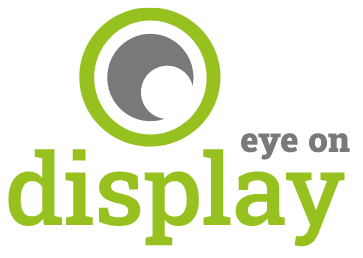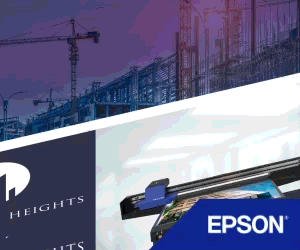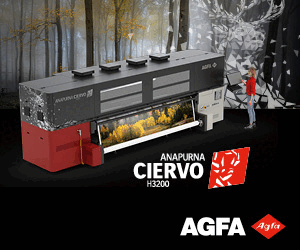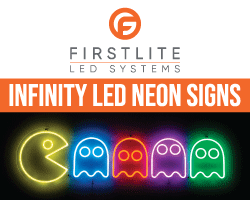One of the hot talking points at FESPA this year was the buzz around the Agfa stand, which enjoyed the global launch of three new printers at the show. We caught up with Mike Horsten to find out more.

Agfa has been undergoing a significant corporate transition from analogue to digital technology. With its long and strong history in print, this shift has not been easy. However, the company is determined to move away from traditional offset methods and embrace new digital technologies. And with exciting new printers from Agfa, it is doing it very well.
According to Mike, the sale of its offset technology to ECO3 and the acquisition of Inca has brought about a notable change in Agfa’s perception, both externally and internally. “The company is witnessing a significant transformation firsthand. For instance, acquiring Inca has led to increased revenue, prompting people within the company to realise the importance of such investments.”
He continues, “Initially, it was difficult for them to understand the necessity of technological advancements. Some questioned why we needed to invest in new technologies when we already possessed the expertise and capability to produce excellent products in-house. Additionally, there were concerns about the integration process, particularly with the acquisition of Inca. People worried about how such a large-scale integration would affect us.
“However, in a surprisingly short period, not even two years yet, the integration process has been remarkably smooth. There has been extensive collaboration and interaction between our company and the former Inca Digital team in Cambridge, leading to a deep understanding of each other’s strengths and capabilities.”
Positioning the new printers from Agfa
Another major development for Agfa has been the creation and clarification of the identity of its huge range of products. At FESPA, the new printers from Agfa introduced the concept of ‘a Beast for Every Need’, using an animal metaphor based on size, speed and character. “Navigating our huge and diverse portfolio of products has its challenges. From compact UV flatbed hybrid machines to larger commercial machines, we wanted a clear and simple way of highlighting the broad spectrum of offerings we provide. Despite the complexities involved, our aim is to position our products effectively in the market to help customers identify with what they need,” says Mike.
“So, it’s crucial for us to carefully consider how we position our products in different countries and regions. What we showcased at FESPA or talk about in Europe may not necessarily be suitable for all markets worldwide. Some products simply don’t have demand or a market in certain regions.”
To address these diverse market needs, Agfa has segmented its platforms into five or six different categories. The Anapurna line, which is now branded as Ciervo (Spanish for deer), is one example. Within this is a range of products from 160cm to 320cm in width, with different speeds and applications, such as roll-to-roll or hybrid.
Mike explains what sort of companies and businesses the new machines are aimed at. “The Anapurna line primarily caters to small businesses with two to twelve employees, often operating at a regional or local level and producing relatively small quantities. These companies aren’t necessarily our direct customers and are often serviced through our regional distributors and resellers.”
“Moving up the scale to the 12-20 people-sized companies, we have the new Jeti: Bronco range. The first machine in this range is available, and we plan to introduce multiple models later this year. The Bronco range comes with two lanes of printheads, which can later be upgraded to a four-lane machine, effectively doubling its speed. The two-lane machine will be available in September and we expect to start supplying the four-lane machine in October or November, allowing companies to upgrade in the field.”
“As we move into larger companies, we see demand for the Jeti: Tauro (bull) or Onset Grizzly from companies like Delta, which require even higher speeds and reliable quality for applications in supermarkets and retail giants like Walmart. These machines can handle speeds of 600+ boards per hour or 1400+ square meters per hour, with full automation and robotisation.”
“Finally, there is the industrial market which we target with the Speedset Orca (formerly the Inca Digital range). This includes the B1 folding carton market, which demands incredibly high speeds, such as 11,000 boards per hour, catering to industrial-scale production needs.”

Digital transformation in packaging
Mike continues, “The shift from offset to digital occurred years ago in industries like printing and copying. Now, we’re witnessing a similar transformation in corrugated packaging. Many corrugated manufacturers realise that the old methods are no longer profitable, especially with typical order sizes significantly decreasing. This shift poses challenges for larger converters who are geared towards high-volume production. However, when you transition to a setup that accommodates smaller runs, such as producing 5000 boxes per hour instead of 50,000, the dynamics change significantly. There’s less need for changeovers and machine cleaning. While some embellishments may be easier with digital technology, others, like high-speed foiling, may still require separate processes due to the limitations of cutting at such speeds.”
“The digital transformation is clearly happening, and in recent years, Agfa has made significant progress in developing a comprehensive product line that caters to diverse needs, from top-tier industrial solutions to smaller-scale applications.”
The Agfa difference
Mike says it is always challenging for the major manufacturers to articulate the distinct benefits of their printers because they are all well-built and perform admirably. “For Agfa, the main strength and advantage we have over our competition is our holistic approach. Our printers are not just machines; they’re one-stop solutions. We develop our own software, manufacture our own inks, and provide our own service.”
“Additionally, our service is localised, meaning that if you buy a machine in Brazil, you’ll have access to local support and services. While most other manufacturers piece together machines using components from various suppliers, we design our printers from the ground up, ensuring seamless integration and optimal performance. We manufacture everything ourselves, ensuring optimal compatibility and performance. This includes our inks, whether UV or water-based, all formulated in-house. Moreover, all production occurs in our facilities, ensuring quality control and adherence to our standards.”
“Agfa’s strength lies in our meticulous approach to component matching, which is made possible by our in-house development of all major components. Research and development teams are constantly innovating, ensuring that our machines are tailored to meet the specific needs of different markets. This comprehensive approach sets us apart and ensures that our printers deliver unmatched quality and reliability.”
A sustainable approach
Agfa’s integrated approach ensures a solid business foundation and long-term vision. “Despite industry changes, such as the decline of film photography, Agfa has adapted by repurposing its facilities for sustainable endeavours, like membrane production for green hydrogen. This aligns with our commitment to sustainability, complementing initiatives like our animal-themed branding. Ultimately, while sustainability is a key focus, we acknowledge that there’s always room for improvement,” he says.
“We recognise that achieving sustainability across our product lines is complex and ongoing. Our ethos of ‘Powered by Nature.’ is about matching the right product to the right need, which inherently aligns with sustainability goals. However, sustainability goes beyond product development; it permeates our corporate culture, guided by regulations, internal policies, and a genuine commitment from senior management to environmental stewardship.”
“As a company with roots in the chemical industry, we understand the significance of sustainability in digital printing, where chemicals play a crucial role. We’re actively working to make our processes and products more sustainable. For example, products like the SpeedSet Orca and InterioJet, showcase our strides towards sustainability by utilising water-based inks that outperform traditional UV-based alternatives.”
Mike is realistic in saying that achieving full sustainability won’t happen overnight. “It’s an ongoing journey, and we’re committed to making steady progress. This commitment is essential not only for the future of Agfa but also for our growth in key sectors like digital printing and healthcare IT. In healthcare, our share of it is expanding, especially in the US, where our healthcare IT solutions are thriving.”
“However, it’s important to note that while we’re making strides in sustainability, there are still challenges, particularly in regions where resources are limited and older technologies persist due to financial constraints. Overall, our approach to sustainability is multifaceted, encompassing product development, corporate practices, and a commitment to gradual improvement. While there may be hurdles along the way, we’re dedicated to navigating them with transparency, diligence, and a long-term vision for a more sustainable future.”
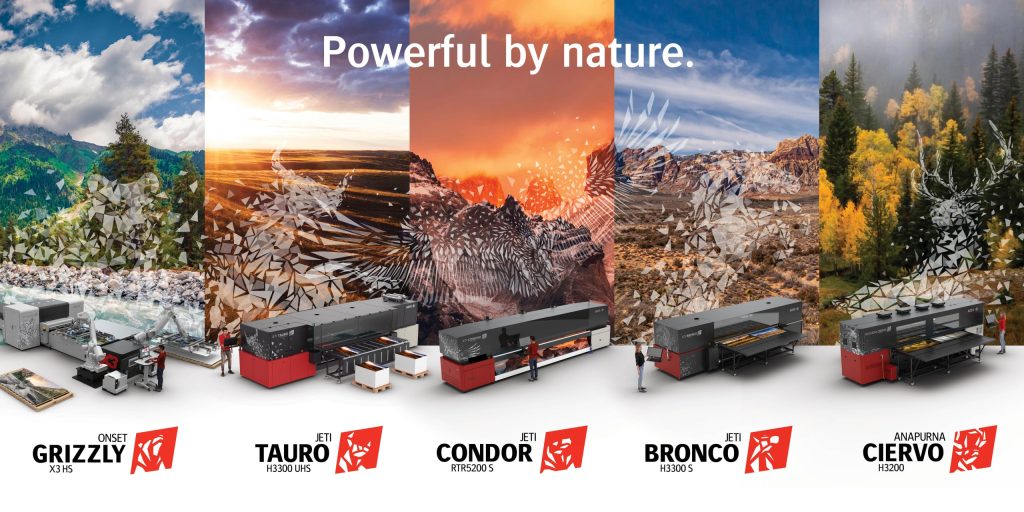
To the future
In conclusion, Mike is extremely positive for Agfa’s future, “Our plan is well underway, with the next stage of printers set to be available later this year. As we move forward, one of our key focuses is automation, which addresses a critical issue for both Europe and the US, which is the shortage of qualified operators. Automation presents a significant advantage for the future, allowing us to streamline processes and improve efficiency. By controlling both the software and hardware aspects, we can ensure seamless integration and optimal performance.”
“At Agfa, our overarching vision is to be the singular point of contact for our customers. We aim to provide solutions that just work, minimising downtime and maximising productivity. Looking ahead, Agfa will continue to evolve and embrace new technologies, including developing innovative new inks. Throughout this, it is important that we remain focused on delivering practical solutions that meet the needs of our customers.”
